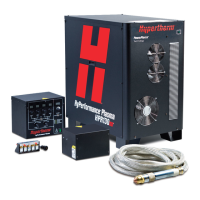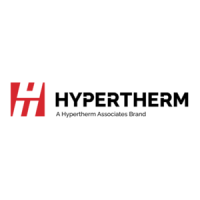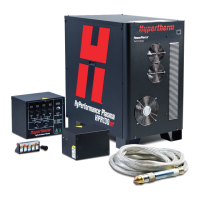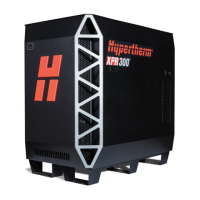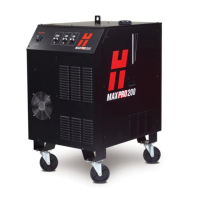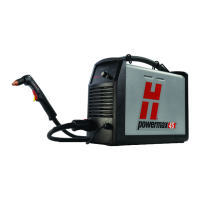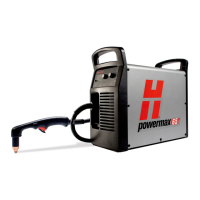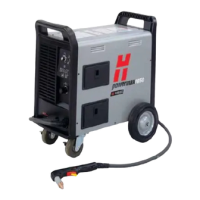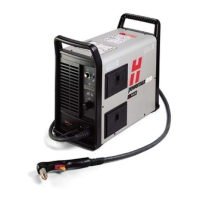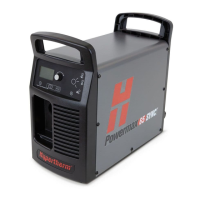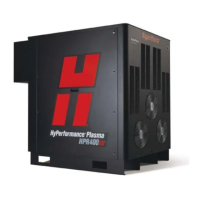
Do you have a question about the Hypertherm HyPerformance HPR400XD Auto Gas and is the answer not in the manual?
| Brand | Hypertherm |
|---|---|
| Model | HyPerformance HPR400XD Auto Gas |
| Category | Welding System |
| Language | English |
Ensuring compatibility of Hypertherm's CE-marked equipment with EN60974-10 standard.
User responsibility for installation and use to achieve EMC.
User assessment of potential electromagnetic problems in the surrounding area.
Techniques for reducing electromagnetic emissions from the cutting equipment.
Connecting cutting equipment to mains supply and precautions for interference.
Routine maintenance procedures for cutting equipment to ensure EMC.
Guidelines for positioning and managing cutting cables for EMC.
Considerations for bonding metallic components for EMC.
Procedures and considerations for earthing the workpiece for electrical safety and emissions.
Selective screening and shielding of cables and equipment to reduce interference.
Information regarding genuine Hypertherm parts and user responsibility for safe use.
Hypertherm's warranty terms for plasma power supplies, torches, and related components.
Hypertherm's commitment to defend against patent infringement suits.
Exclusion of Hypertherm's liability for incidental, consequential, or exemplary damages.
Precedence of national and local codes over manual instructions.
Limits on Hypertherm's aggregate liability for claims arising from product use.
Requirement to maintain adequate insurance coverage.
Conditions and procedures for transferring warranty rights.
Verification of received components and inspection for shipping damage.
Procedure for filing claims for damage during shipment or defective merchandise.
Conformity to national/local codes and need for qualified personnel for electrical/plumbing work.
Information on acceptable noise levels and necessary ear protection.
Guidelines for positioning system components before making connections.
Practices for grounding and shielding to protect against RFI and EMI.
Explanation of service ground, DC power ground, and RFI/EMI grounding.
Diagram illustrating grounding of components in a plasma cutting system.
Guidelines for placing the power supply in a suitable environment.
Instructions and safety precautions for lifting and moving the power supply.
Instructions for mounting the ignition console in vertical or horizontal positions.
Guidelines for placing the cooler in an area with proper ventilation and clearance.
Instructions for mounting the metering console near the torch lifter station.
Guidelines for placing the selection console near the cutting table for servicing.
Details for connecting pilot arc and negative leads between power supply and ignition console.
Information on the ignition console power cable, including part numbers and signal list.
Details on connecting coolant hoses, including part numbers and caution.
Information on the control cable connecting power supply to cooler.
Information on the power cable connecting power supply to cooler.
Details for connecting control cable between power supply and selection console.
Details for connecting power cable between power supply and selection console.
Instructions for connecting selection console to metering console with cable and gas hose.
Details on the power supply to CNC interface cable, including pinouts and notes.
Information on optional CNC interface cables for multi-system configurations.
Diagrams illustrating various output circuit configurations.
Diagrams illustrating various input circuit configurations.
Instructions for connecting a remote ON/OFF switch.
Details and part numbers for the torch lead assembly.
Information on the optional torch lead junction box for installation flexibility.
Steps for mounting and grounding the torch lead junction box.
Instructions for connecting leads to the junction box and ignition console.
Specific steps for connecting the junction box lead to the ignition console.
Instructions for connecting the lead from the torch to the junction box.
Details and part numbers for the work lead.
Procedure for connecting the torch to the torch lead assembly.
Step-by-step guide for assembling the torch to its lead assembly.
Instructions for connecting the torch body to the quick-disconnect receptacle.
Guidelines for mounting and aligning the torch for proper operation.
Specifications for the required torch lifter for the system.
Information on HyperNet for connecting Hypertherm components.
General guidelines for selecting switches, fuses, and power cables.
Function and installation requirements for the line disconnect switch.
Information on selecting and installing the main power cable.
Steps for connecting power cable to the power supply and line disconnect switch.
Guidelines for selecting and using correct coolant mixtures for operating conditions.
Recommendations for coolant mixtures for temperatures below -12°C (10°F).
Recommendations for coolant mixtures for temperatures above 38°C (100°F).
Specifications for water purity to prevent nozzle deposits and ensure arc stability.
Procedure for filling the cooler with coolant and purging air from the system.
Information on furnishing gases and gas-supply regulators.
Procedure for setting supply regulator pressures for shield and plasma gas.
Recommendations for high-quality gas regulators available from Hypertherm.
Guidelines for rigid copper plumbing or flexible hose for gas supplies.
Instructions for connecting supply gases to the selection console.
Part numbers for oxygen, nitrogen/argon, air, and H35/F5 hoses.
Ensuring a safe cutting environment and proper clothing before start-up.
Procedure for checking torch consumables for wear or damage.
Description of power indicators (LED lamps) on system components.
Required elements for CNC setup, real-time display, and diagnostics.
Reference screens for main control, diagnostic, test, and cut charts.
Guidance on selecting consumables for standard, bevel, and marking processes.
Consumable parts diagrams for mild steel cutting at various amperage levels.
Consumable parts diagrams for stainless steel cutting at various amperage levels.
Consumable parts diagrams for aluminum cutting at various amperage levels.
Consumable parts for mild steel bevel cutting at various amperage levels.
Procedure for installing and inspecting consumables, including safety warnings.
Guidelines for maintaining the torch to ensure cut quality and prevent premature failure.
Procedure for connecting torch components and replacing the water tube.
Troubleshooting common cutting issues and their potential causes.
Tips and procedures for achieving square, straight, smooth, and dross-free cuts.
Strategies to maximize consumable life, including starting and stopping cuts on the workpiece.
Factors influencing cut quality, such as cut angle and torch-to-work distance.
Considerations for improving piercing capability, including lead-in distance and material chemistry.
Recommended consumable parts, cutting speeds, and gas settings for various processes.
Process for thin stainless steel cutting achieving sharp edges and smooth finish.
Technique for extending stainless steel piercing capability using moving pierce.
Processes for cutting mild steel to achieve optimal finish and angle deviation.
Information on cut charts and consumables for bevel cutting applications.
Using dynamic cut charts for accurate bevel cutting results with mild steel.
Definitions of terms related to bevel cutting, such as bevel angle and clearance.
Charts for optimal results when cutting mild steel underwater.
Reference values for kerf-width compensation based on material and thickness.
Understanding safety symbols and related instructions to avoid hazards.
Reading safety messages, keeping labels in good condition, and proper operation.
Ensuring equipment is in safe operating condition before use.
Responsibilities of workplace entities and contractors for safety.
Warning about potential damage to frozen pipes from plasma arcs.
Precautions for handling printed circuit boards to prevent static damage.
Securely attaching work leads and connecting the cutting table to earth ground.
Safety procedures for opening equipment enclosures and servicing energized equipment.
Precautions to prevent electric shock from live electrical parts.
Fire prevention measures and explosion hazards during cutting operations.
Safety advice to prevent operator injury from hazardous moving parts of the cutting system.
Safety guidelines for using compressed gas cylinders, regulators, and hoses.
Information on toxic fumes produced by cutting and methods to reduce exposure.
Safety information regarding immediate ignition of plasma arcs and keeping clear of the torch tip.
Guidelines for eye and skin protection from plasma arc rays.
Considerations for pacemaker and hearing aid users regarding magnetic fields.
Information on protecting hearing from excessive noise levels during cutting or gouging.
Information on dry dust representing a potential explosion hazard in some workplaces.
Safety instructions to avoid eye injury from laser beams.
List of safety standards and recommended practices for welding and cutting.
General description of HyPerformance plasma systems and their capabilities.
Details on the power supply's amperage, voltage, and serial interface.
Description of the cooler's function, heat exchanger, pump, and sensors.
Functionality of the ignition console, including spark-gap assembly and high-voltage pulses.
Management of plasma gas selection and mixing by the selection console.
Control of gas flow rates in real time and LongLife process gas portion.
Specifications for the HyPerformance torch's cutting capacity.
Requirements for gas quality, pressure, and flow rates for different gases.
Technical specifications for the power supply, including voltage and amperage ratings.
Specifications for the cooler, including coolant capacity and dimensions.
Specifications for the ignition console, including mounting options and cable length.
Details on the optional junction box for increased installation flexibility.
Specifications for the selection console, including cable lengths and mounting.
Specifications for the metering console, including cable length and mounting.
Specifications for the torch, including diameter and minimum bend radius for leads.
Explanation of common symbols used on power supply, controls, and LCD screen.
Explanation of various markings and certifications on the product.
Assumptions about service personnel qualifications and safety considerations.
Reference to preventive maintenance schedule and contact for technical services.
Overview of system components and power/signal cable connections.
Description of power and CAN bus signal cables for system components.
Step-by-step description of system operation from power-up to auto-off.
Explanation of the preflow and cutflow purge cycles and exceptions.
Tables showing active valves for each cutting process and marking.
Information on active valves during marking processes and variations based on previous processes.
Overview of error codes displayed on the CNC screen and diagnostic screen.
Troubleshooting procedures for various error codes.
Display of power supply states on the CNC screen.
Flowchart illustrating plasma system operation with pump time-out logic.
Flowchart illustrating CNC operation with pump time-out logic.
Visual check and voltage verification before troubleshooting.
Procedure for measuring line voltage at the power supply terminal block.
Steps for replacing the air filter element, including precautions.
Procedures for servicing the coolant system, including draining and filter replacement.
Flowchart to diagnose and resolve coolant flow issues.
Tests to determine the cause of coolant flow problems.
Procedure to verify the bypass valve function in the cooler.
Instructions for obtaining accurate readings using the Hypertherm flow meter.
Procedure for manually operating the pump via the CNC screen.
Test to measure flow rate in the return line.
Test to measure time taken to fill a container from the supply line.
Test procedure involving changing the torch and checking flow rate.
Test to measure time taken to fill a container from the supply line to the torch receptacle.
Test to measure time taken to fill a container from the return line at the ignition console.
Procedure to measure fill time using a bucket test at the pump.
Troubleshooting steps for pump and motor issues based on LED status.
Procedure for testing the flow sensor's voltage output.
Procedures for performing inlet, system, and proportional valve leak tests.
Diagram and test points for the power supply control board PCB3.
Diagram and LED list for the power supply power distribution board PCB2.
Diagram and troubleshooting information for the start-circuit PCB1.
Table showing pilot arc and transfer current levels based on plasma gas and amperage.
Diagram and LED list for the pump motor drive board PCB7.
Diagram for the cooler power distribution board PCB1.
Diagram and test points for the cooler sensor board PCB2.
Diagram and LED list for the selection console control board PCB2.
Diagram for the selection console power distribution board PCB1.
Diagram and LED list for the AC valve-driver board PCB3.
Diagram and LED list for the metering console control board PCB2.
Diagram for the metering console power distribution board PCB1.
Information on automatic chopper tests during power-up and troubleshooting.
Procedure for troubleshooting Chopper 1 failure, including contact inspection.
Troubleshooting steps for Chopper 2, 3, or 4 failures, including OCV measurement.
Procedure for testing phase-loss detection, including fuse testing and wiring verification.
Procedure for testing torch leads, including jumper wire installation and ohm value measurement.
Information on Hypertherm's Preventive Maintenance Program (PMP).
List of part numbers and descriptions for the power supply unit.
List of part numbers and descriptions for the cooler assembly.
List of part numbers and descriptions for the ignition console.
Part numbers for the optional torch lead junction box and its fittings.
Part numbers for lead sets connecting the ignition console to the junction box.
List of part numbers and descriptions for the selection console.
List of part numbers and descriptions for the metering console.
Parts list for the HyPerformance torch assembly, including components and kits.
List of consumable parts kits, including mild steel and stainless steel kits.
Diagrams of consumables for mirror-image cutting of mild steel.
Diagrams of consumables for straight cutting of mild steel.
Consumables for mild steel cutting at various amperage levels.
Consumables for stainless steel cutting at various amperage levels.
Consumables for mild steel bevel cutting at various amperage levels.
List of recommended spare parts for power supply, cooler, and ignition console.
Explanation of the organization and referencing format for wiring diagrams.
Identification of wiring diagram symbols used in the section.
Explanation of the functionality of discrete output signals.
Wiring diagram for optional multi-system interface.
Wiring diagram for optional Command THC interface.
Product identifier, chemical name, supplier contact details, and uses of the substance.
Hazard classification according to EC and GHS regulations.
Information on hazardous ingredients like Propylene Glycol and Benzotriazole.
First aid procedures for inhalation, skin contact, eye contact, and ingestion.
Information on extinguishing media and protective equipment for fire conditions.
Precautions and environmental exposure controls for accidental spills.
Guidelines for safe handling, storage, and specific use of the product.
Information on occupational exposure limits and necessary personal protective equipment.
Data on appearance, odor, pH, boiling point, flash point, and other physical properties.
Information on reactivity, chemical stability, and hazardous decomposition products.
Data on acute toxicity, eye/skin irritation, sensitization, mutagenicity, and carcinogenicity.
Information on persistence, biodegradability, mobility in soil, and PBT assessment.
Guidelines for waste treatment and disposal in accordance with local legislation.
Classification and transport information for the product.
Regulatory information for USA and Canada, including TSCA, SARA, and WHMIS classifications.
Legend for exposure limits, references, training advice, and additional information.
Description of interface hardware, including discrete signals and RS422 interface.
List of signals, their types, and descriptions for CNC interface.
Specifications for inputs and outputs, including voltage levels and load resistance.
Diagram illustrating multi-drop wiring for connecting multiple HPR systems to a CNC.
Setting power supply ID using DIP switches and implementing multi-drop interface.
Format, framing, and commands for serial communication with the system.
ASCII-based protocol details: baud rate, data bits, stop bit, parity, and flow control.
Structure of serial messages, including start, command ID, data, checksum, and end.
Description of command responses and error handling.
Table listing commands, their systems, and descriptions.
Information on error responses for bad checksum and bad command.
Method for calculating checksums for serial commands.
List of error codes with their names and descriptions.
List of system status codes and their meanings.
List of gas type codes used by the system.
Functionality required from CNCs for automatic gas console operation.
List of functionalities CNCs must offer for the automatic gas console.
Guidelines for serial interface communication, including checksum and message retries.
Importance of maintaining cable shielding integrity for EMI protection.
List of components for robotic applications, including torch leads and ohmic contact extension.
Details on torch leads designed for robotic or bevel applications.
Information on Ohmic contact wire and its extensions.
Description of the rotational sleeve for applications with twisted torch leads.
Details on the rotational mounting sleeve clamp.
Description of the leather overwrap for lead protection from molten metal splash.
Information on mounting the laser pointer for torch positioning and alignment.
Dimensional drawings for the torch and rotational mounting sleeve.
Dimensional drawings for the rotational mounting sleeve clamp.
